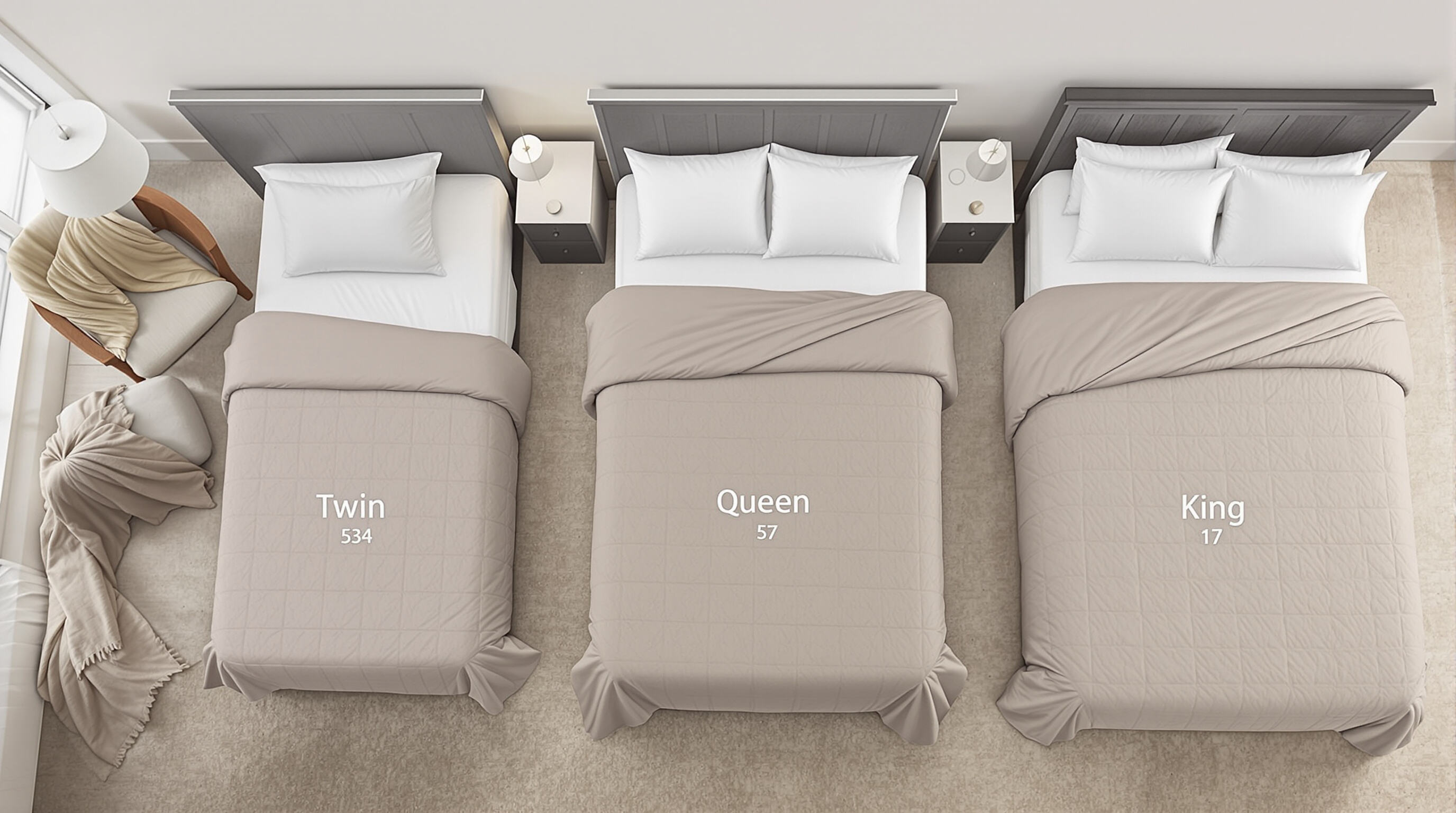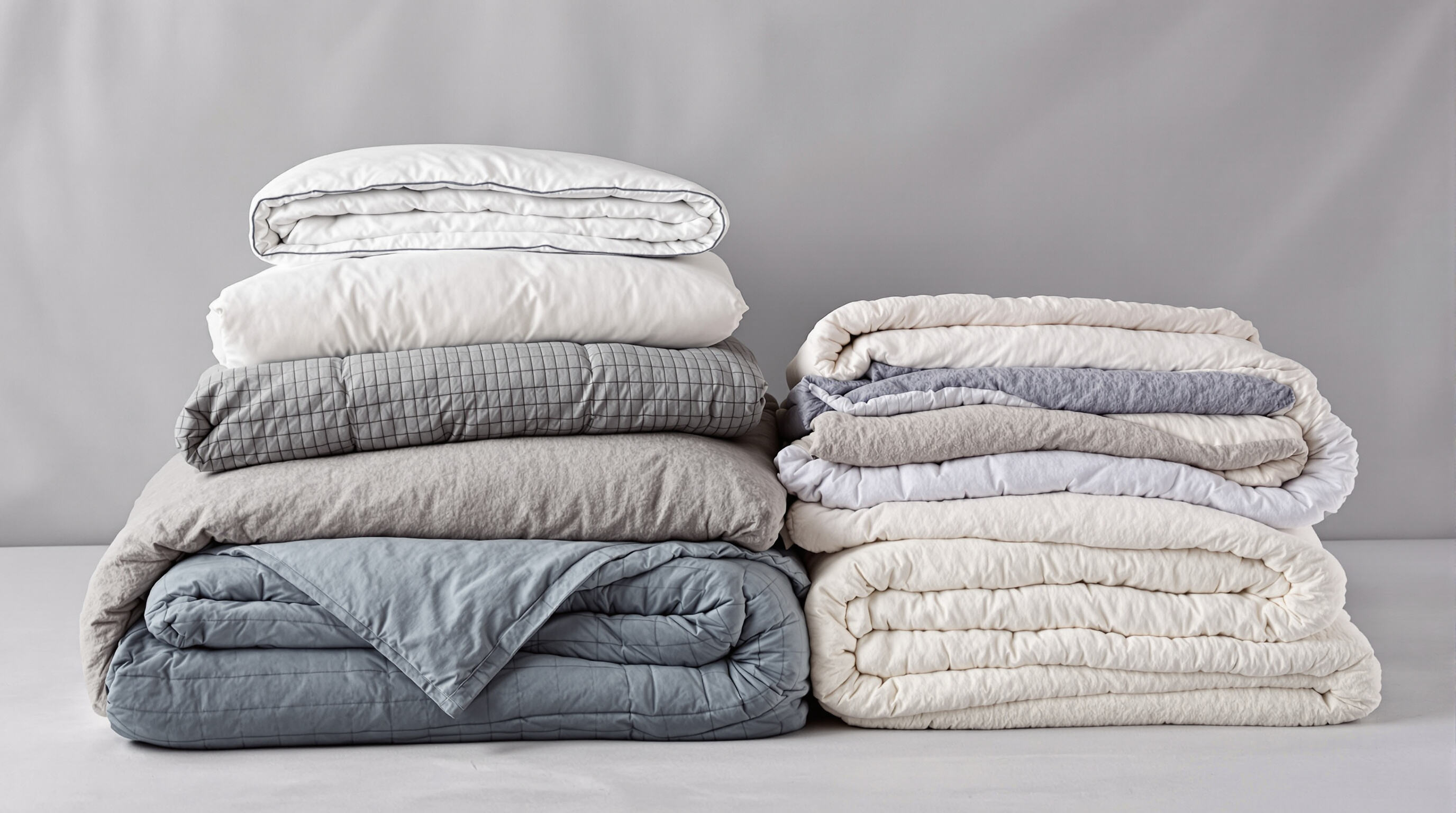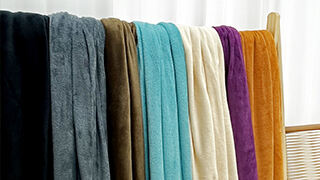Understanding Blanket Set Sizes and Proper Bed Fit

Blanket Size and Fit: Twin, Queen, King, and Throw Size Explained
When picking out blankets, getting the sizes right matters a lot. Twin sized ones measure around 65 by 90 inches and work great for people who sleep alone. For bigger beds, queen size blankets at about 90 by 100 inches cover most queen mattresses comfortably, while king size options stretch to roughly 108 by 90 inches. Then there are throw blankets, usually smaller at 50 by 60 inches. These aren't really meant to fully cover a bed but more as extra layers or something to drape over furniture. A recent survey from last year found that nearly three quarters of shoppers care about making sure their blanket matches their mattress size so it doesn't slide around all night. Makes sense since nobody wants to wake up with half their blanket on the floor!
| Mattress Type | Blanket Dimensions | Coverage Adequacy |
|---|---|---|
| Twin | 65" x 90" | Full edge draping |
| Queen | 90" x 100" | 12" side overhang |
| King | 108" x 90" | Even distribution |
How to Match Blanket Dimensions to Mattress Measurements
It makes sense to check out the dimensions of your mattress first when picking out blankets. A queen size mattress usually measures around 60 inches by 80 inches, so look for a blanket that's about 90 inches wide to give yourself roughly 15 inches of space on either side. Things get trickier with thicker mattresses though, especially ones going beyond 14 inches thick like pillow top varieties. These need longer blankets. Most folks find that increasing standard sizes by about 10 percent works pretty well. That little extra helps keep the blanket from bunching up during the night.
Common Sizing Mistakes When Buying a Blanket Set
When shoppers forget about mattress depth, it ends up being responsible for around 41% of all size-related returns. People often make mistakes like grabbing throw blankets instead of proper bedding, which leaves roughly 60% of their mattress completely uncovered at night. Another common problem happens when folks assume regular king size blankets will work on California King beds. Surprise! Those aren't quite compatible since California Kings are actually 4 inches longer than standard kings. And let's not forget about taller sleepers either. Anyone standing over six feet tall really needs those extra 12 inches in blanket length just so their feet stay covered throughout the night without dragging them down or constantly adjusting.
Types of Blanket Sets and Their Functional Differences

Types of Blankets: Comforter, Duvet, Quilt, Throw, and More Compared
There's quite a difference between various blanket sets when it comes to how they're built and what they do. Comforters have insulation sewn right inside them either down or those synthetic fills we see so much these days and work great as one piece covers for beds. Then there are duvets which come with separate covers and inserts. This makes them easier to wash and lets people swap out inserts depending on the season for better warmth control. Quilts tend to be thinner things made from multiple layers of fabric stitched together in pretty patterns. They usually sit on top as decoration rather than being the main coverage. Throw blankets measure around 50 by 60 inches typically and give that extra layer of warmth without weighing someone down too much, perfect for laying across a couch or adding to bedroom decor. For folks living somewhere cold, wool blankets regulate body temperature naturally throughout the night. Hot sleepers might prefer bamboo based options since they actually help cool things down during sleep.
| Blanket Type | Primary Use | Warmth Level | Structure |
|---|---|---|---|
| Comforter | Bed covering | High | Single-piece with sewn channels |
| Duvet | Modular bed layer | Adjustable | Insert + removable cover |
| Quilt | Decorative layer | Medium | Stitched fabric sandwich |
| Throw | Accent/light cover | Low | Single-layer or thin weave |
Differences in Structure, Filling, and Outer Fabric Between Blanket Types
How well a blanket works really comes down to what it's made of and how it's put together. Down comforters rated at 750 fill power or higher keep people warm and fluffy, though they do need some attention now and then to stay cozy. For those worried about allergies, synthetic filled duvets tend to hold up better against allergens and generally keep their shape longer compared to natural fibers. Cotton quilt sets strike a nice middle ground between letting air circulate and lasting through many washes because of those little squares in the fabric. And let's not forget about bamboo or eucalyptus throws which seem to pull sweat away from skin quicker than regular cotton does, making them great companions for folks who tend to get hot during sleep.
When to Choose a Duvet Set vs. a Quilted Blanket Set
Duvet sets tend to be the go to choice when someone cares about how easy they are to clean since most come with machine washable covers. They also offer good seasonal flexibility because people can swap out different inserts depending on what time of year it is. Plus there are plenty of hypoallergenic options available these days like microfiber inserts that don't attract dust or mold growth. On the other hand quilted bedding has its own advantages too. These sets look really nice on beds and stay put without sliding around all night long. Many folks find them great for building layers during those not too hot not too cold months. And the tight weave of cotton used in quilts makes them particularly good for anyone dealing with allergies as the fabric naturally resists dust mites.
Seasonal Adaptability of Different Blanket Set Types
For winter, pair high-loft down duvets (90/10 feather ratio) with wool throws for maximum warmth. In summer, opt for bamboo-cotton quilts (200–300 GSM) or moisture-wicking linen sets. During spring and fall, medium-weight comforters with TOG ratings between 4 and 7 provide balanced insulation.
Material Composition: Choosing the Best Fabric for Your Blanket Set
Blanket Materials: Cotton, Wool, Down, Silk, Eucalyptus, and Bamboo Analyzed
When it comes to quality blankets, natural fibers remain a top choice because they just feel better against skin and work well over time. Take cotton for instance, which appears in around two thirds of homes across the country. People love cotton because air can pass through it easily and washing isn't a big deal. Then there's wool, which handles sweat really well and keeps folks warm even when temperatures drop below freezing outside. Down feathers give blankets that wonderful fluffiness and warmth factor, though many manufacturers mix them with other materials nowadays since some folks have allergies to pure down. For those looking for something different, plant based options such as bamboo fabric and eucalyptus blends offer extra softness plus they resist bacteria growth naturally. And let's not forget about silk blankets either, although these tend to cost quite a bit more than alternatives on the market today.
Material Types and Their Benefits: Breathability, Softness, Durability
| Material | Breathability | Softness | Durability (Wash Cycles) |
|---|---|---|---|
| Cotton | High | Medium | 300+ |
| Bamboo | Very High | High | 200 |
| Wool | Medium | Medium | 500+ |
| Polyester | Low | Variable | 400+ |
Cotton's versatility makes it suitable for year-round use. Bamboo absorbs 40% more moisture than cotton, benefiting hot sleepers. Wool's natural lanolin repels odors and extends wear time despite requiring more careful maintenance.
Eco-Friendly Materials Like Tencel, Viscose, and Organic Cotton in Blanket Sets
The world of sustainability has expanded to include closed loop production fibers that recycle waste back into new products. Take Tencel for instance, made from sustainably sourced wood pulp, which requires roughly 80 percent less water compared to regular cotton farming practices. Then there's organic cotton cultivation that skips the chemical pesticides altogether, cutting down on harmful runoff into local ecosystems. Bamboo viscose is another interesting alternative since bamboo plants can grow at astonishing speeds, about 39 times quicker than traditional cotton crops, meaning we need far less acreage to produce similar quantities. All these eco friendly materials pass strict OEKO TEX certification tests regarding both safety factors and functional qualities. The catch? Prices usually run between 20 to 30 percent higher than standard fabrics, so budget considerations remain important when choosing greener options for manufacturing.
Synthetic vs. Natural Fibers: Performance and Sustainability Trade-Offs
Budget friendly clothing often uses polyester blends because they last longer and resist stains pretty well. But there's a catch. Microfiber versions shed tiny plastic particles during most washes, something Ocean Conservancy found happens about 8 out of 10 times. Nature does things differently. Cotton and wool can break down in around five years while polyester takes centuries to decompose properly. Some companies are now making recycled fleece blankets from roughly fifty used plastic bottles each. This approach strikes a balance between what we can afford and what's better for the planet, though it still falls short of completely solving the problem.
Thermal Performance and Temperature Regulation in Blanket Sets
Warmth and weight metrics: GSM, fill power, and insulation levels demystified
How well something keeps us warm depends on several measurable factors. Take GSM for instance - this stands for grams per square meter and basically tells us how dense a fabric is. Fabrics with over 300 GSM tend to be those heavy duty winter materials we all know. Then there's fill power which looks at how fluffy and insulating down really is. Anything rated above 650 points towards high quality stuff. Recent research from 2024 looked into fabrics that regulate temperature naturally. They discovered something interesting about phase change viscose fabric. Even at only 220 GSM, these materials trap body heat around 23 percent better compared to regular cotton. That makes them pretty impressive considering their lighter weight.
How blankets regulate body temperature through breathable materials
Breathable fabrics like organic cotton and merino wool manage moisture while insulating, preventing overheating. Research in Energy and Built Environment (2024) shows these materials keep core body temperature within ±0.5°C of the optimal 36.5°C, improving sleep quality by 31% compared to synthetic polyester.
Cooling properties and lightweight construction for summer use
For warm climates, bamboo-derived rayon and Tencel offer 40% higher airflow than cotton, based on thermal imaging tests. Lightweight constructions under 200 GSM, combined with open-knit weaves, enhance evaporative cooling—critical for maintaining the ideal 28–30°C sleep microclimate.
Best options for cold weather: High-loft down and wool blanket sets
High-loft down (800+ fill power) and tightly woven wool retain heat 2.3 times longer than acrylic alternatives in sub-zero conditions. The most effective cold-weather blankets pair these insulating materials with a medium-weight shell (300–400 GSM) to block drafts while allowing minimal moisture escape.
How to Choose the Right Blanket Set: A Practical Buying Guide
Step-by-step shopping guide for selecting the right blanket set
Start with getting accurate measurements of the mattress so there's about 8 to 12 inches hanging off each side when placed on the bed frame. When picking out fabric options, think about what works best for local weather conditions and how one sleeps. Cotton and bamboo sheets tend to breathe well during hot months, while wool or those down alternatives are great for keeping warm through colder nights. The thickness matters too - something around 200 to 300 grams per square meter is usually comfortable enough for summer sleeping, but go for anything above 400 GSM if winter nights get really chilly. Don't forget to check for quality seals from trusted organizations such as OEKO-TEX or GOTS, these labels help confirm both product safety standards and environmental responsibility claims made by manufacturers.
How to balance price, quality, and material sustainability
Organic cotton and linen tend to set people back around 20 to 40 percent extra compared to synthetic materials, but they hold up way better over time lasting anywhere from three to five times longer which actually cuts down on how often things need replacing. Speaking of alternatives, wool blended with acrylic gives about 75% of pure wool's warmth while costing roughly half what good quality wool would normally go for, so it makes sense for folks who want something warm without breaking the bank. Those really concerned about sustainability might look into bamboo lyocell fabrics or Tencel™ products instead. These materials break down naturally when discarded, are gentle on sensitive skin, and generally leave behind much less of an environmental footprint than most conventional textiles do these days.
Top-rated blanket sets based on user needs and expert reviews
The all season down alternative bedding sets with around 300 to 400 GSM rating tend to get high marks from users because they work well across different temperatures, keeping things comfortable when room temps hover between about 65 and 75 degrees Fahrenheit. Sheets made from cooling eucalyptus or bamboo fabric seem to cut down on night sweats quite a bit, maybe around thirty percent less than regular cotton polyester mixes, which makes these materials pretty good choices for folks living in warmer areas. When it gets really cold outside, those heavy duty wool blankets rated at over 500 GSM do an amazing job holding onto body heat, retaining roughly ninety percent of what's generated. Tests show they beat synthetic options hands down, typically performing twice as well in terms of insulation value according to most lab results I've seen.
FAQ Section
What size blanket should I choose for a twin bed?
A twin bed requires a blanket that measures approximately 65" x 90" to ensure full coverage without excess overhang.
Can I use a regular king blanket for a California King bed?
No, regular king blankets are not suitable for California King beds as they're 4 inches shorter in length. Choose a blanket specifically designed for California King size.
Which blanket material is best for hot sleepers?
Bamboo-based and eucalyptus fabrics are ideal for hot sleepers as they provide enhanced breathability and moisture-wicking properties.
Are eco-friendly blanket materials more expensive?
Eco-friendly materials like Tencel and organic cotton can be 20-30% pricier than conventional fabrics, but they offer sustainability and often longer durability.
How do I balance comfort and temperature regulation in blankets?
Select fabrics with high GSM for winter and open-knit, lightweight options under 200 GSM for summer. Natural fibers like wool and cotton are versatile for maintaining an ideal microclimate.
Table of Contents
- Understanding Blanket Set Sizes and Proper Bed Fit
- Types of Blanket Sets and Their Functional Differences
- Material Composition: Choosing the Best Fabric for Your Blanket Set
- Thermal Performance and Temperature Regulation in Blanket Sets
- How to Choose the Right Blanket Set: A Practical Buying Guide
- FAQ Section








